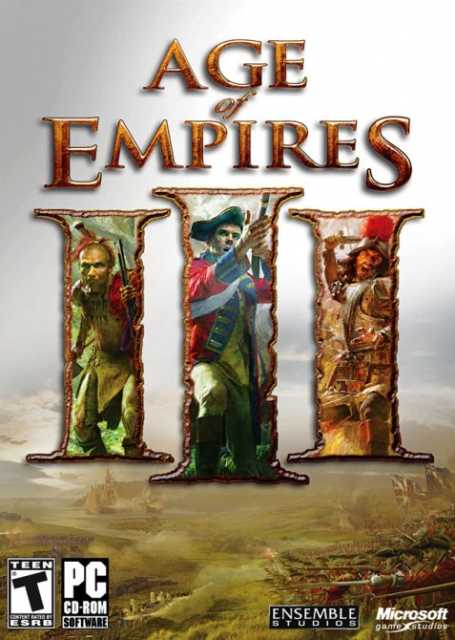Overview
Released in 2005, Age of Empires III (AoE3) portrays the European conquest and further colonization of the Americas between 1492 and 1850 CE. Several innovations are introduced to the franchise's mainstay pillars, most significantly with the addition of the Home City. Each civilization's Home City has an unique bonus that changes the way each one is played. This main change modifies the stock RTS mechanics, introducing some more features akin to Role Playing Games. The franchise as a whole is thrust forward in history from Age of Empires II by several hundred years making good use of the new time period. A dense single-player campaign is split into three acts spanning three generations of the fictional Black family.
Gameplay
While the core of the game remains intact from Age of Empires II, the addition of the Home City significantly changes the entire surrounding package. The Home City functions as a second disconnected city in the game, almost like an imperialistic nation looking out for a budding colony. This allows for more role playing mechanics to brought into the fray as upgrades are persistent across all campaigns, encouraging players to find a play style they are comfortable with and developing their Home City in this direction. This city will occasionally supply you with aid ranging from economic and military upgrades, reinforcements, or surplus resources. Access to these shipments is gained through experience points earned through your actions, and differ from Age to Age. The one kink in this system is that certain shipments can only be received once during each game, requiring you to strategically use them when they are most needed.
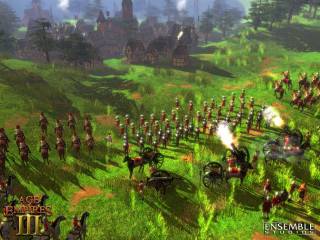
The persistent Home City across all campaigns is developed even further with the introduction of cards that can be played to receive a certain type of shipment. These cards are formed into a deck from which a maximum of 20 cards are selected to be brought into each match. You are allowed to change out cards at the beginning of each campaign mission, giving the player the chance to tailor their deck and the shipments that will be available for the specific mission at hand. Each of the eight civilizations have unique cards with several cards that overlap between them all. As your Home City levels up, progressively stronger cards are introduced - some with prerequisites - allowing more diverse play styles to open up. Not unlike developing your character in a RPG, this mechanic encourages you to stick with one civilization, learning the nuances while reaping the rewards of each level gained.
Unlike previous Age of Empire games, the building of a Wonder does not signify the endgame. In fact, the whole Wonder concept has been taken out, not to be brought back until the second expansion - Age of Empires III: Asian Dynasties. For better or worse, the only way to win a match or campaign is through total conquest. In reality, this stays true to the whole feel of the theater and specific time period chosen for the game, as it is the conquest of the Americas that remains the main focus throughout.
Trade takes a prominent position in AoE3 with the new addition of Trading Posts. Its simplest use allows the player to build and upgrade Native American warriors diversifying the makeup of your army that you have. If Native American villages are present on a map - which is the case the vast majority of the time - Trading Posts can be built. Probably the most effective use of this new building allows a player to receive a tax or toll when it is built along a trade route. The resource that is traded is up to the player and can significantly alter the outcome of the game. Upgrading trading routes allows for speedier travel, which in turn allow supplies and resources to reach the player much quicker. Ultimately, the smart use of the Trading Post can become a major strategy in building a mighty army as supplies are oftentimes the greatest obstacle in being able to win through total conquest of the map.
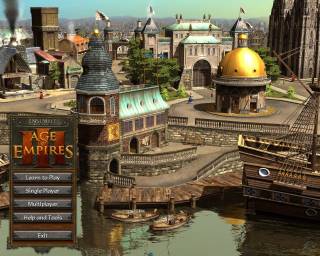
Finally, what seems like a minute change compared to the major gameplay additions in the game, may be one of the most important ways that the game is streamlined. Resource collection and management are simpler with the necessity of dropsites being taken out of the game. With previous games in the franchise, all resources collected were required to be dropped off at a dropsite - usually your Town Center. A settler now has the ability to bypass this step entirely, with every collected item automatically showing up in your stores. This opens up collection across the map exponentially since you no longer have to worry about ensuring that settlers have a quick and easy path to their designated dropsite.
Ages
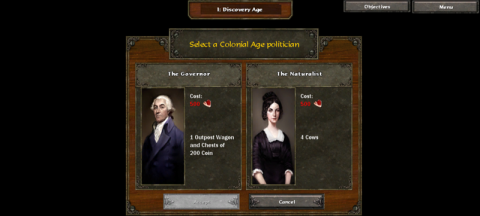
Each campaign or match is divided up into five different Ages that your civilization progresses through. The cards that are available continually become more powerful as each Age passes, and the units available change as well. Each Age represents a specific historical time period in t he conquest and colonization of the Americas. This is similar to the technological phases presented in similar RTS franchises. Before the player can progress to the next Age, a choice between two historical politicians is presented, with a different bonus being associated with either one. As the Home City levels up over the course of several matches (one politician for every 10 levels), more politicians are unlocked giving the player a wider variety of choice in the bonuses that they are able to receive.
Discovery Age
The first age in the game, characterized as the beginning of the European exploration of the American landscape. These are the first steps towards settlements in the New World. A simple economy is present, which includes trade, beginning the formation of an army that will hopefully be capable of conquering enemy colonies.
Colonial Age
This second Age, with the first steps being taken in colonizing the New World, unlocks the first early military units. The Priest introduces the first healing
unit in the game. The requirement to advance to this Age is 800 Food.
Fortress Age
Within the third Age, each colony begins to fortify themselves, unlocking Forts. This advancement allows the player to have a more complete army and military. Major improvements to the economy present themselves here which allow the beginning of an artillery. The requirements to advance to this Age include 1000 Coin and 1200 Food.
Industrial Age
Factories are the major advancement in this fourth Age which produce resources or artillery. A strong economy is the main side-effect of factories opening up all units and cards. By this Age, players are more capable of producing a large army with the ability to fortify themselves. The requirements to advance to this Age include 1200 Coin and 2000 Food.
Imperial Age
Taking place in the mid-1800's this fifth and final Age introduces many expensive, but desirable, technological improvements that can sway that entire game in the favor of the players civilization. All units are available here, and the total conquest of all other civilizations and colonies signals the completion of the match. The requirements to advance to this Age include 4000 Coin and 4000 Food.
Civilizations
Eight civilizations are available in all single- and multiplayer modes. Each have unique strengths and weaknesses making a distinct experience in playing the game. A civilization bonus and a group of unique units for each empire can directly change the way you approach the goals and missions of each campaign. A few secondary civilizations are included that are only playable in the single-player campaign. The Knights of St. John, John Black's Mercenaries, and the United States of America are modified versions of the Spanish, German, and British respectively. The Circle of Ossus, Native Americans, and Pirates are civilizations only playable when using the Scenario Editor.
Spanish
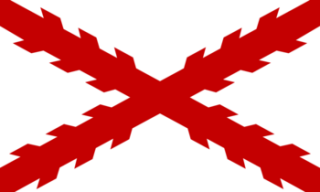
The Spanish military is considered quite strong for their hand-to-hand infantry and cavalry. They have the ability to build a dominant economy late in the game, or attack early due to their Civilization Bonus. This bonus allows home city shipments to be earned faster. The explorer's ability allows for advantages earlier in the game because War Dogs can be trained right away. Unique Home City improvements given to the Spanish benefit their naval forces, soldiers and buildings.
Civilization Bonus:
- The amount of experience required for a shipment from Home Cities is reduced by 27%, making them available faster.
Unique Units:
- Rodelero
- Lancer
- War Dog
Royal Guard Units
- Pikeman
- Rodelero
- Lancer
Home City Ruler
British

The British have the unique ability to focus on gathering wood for the Manor Houses which allow them to spawn villagers at an increased rate. Because of this, they have one of the strongest economies in the game. The Musketeer and the Hussar, which can be upgraded to the Royal Guard level, are two mainline units making their military quite formidable. The British Home City can emphasize its efforts on both the navy and technology.
Civilization Bonus
- Manors replace Houses.
- For every Manor built a free villager is spawned.
Unique Units
- Longbowman
- Rocket
Royal Guard Units
- Musketeer
- Hussar
Home City Ruler
French
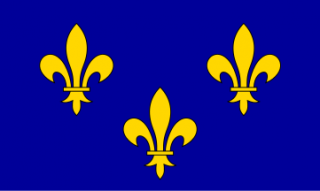
The power of the Coureur unit provides the French with the ability to improve their economy slowly but steadily throughout the game. The main upshot of this strong unit is that they fight better than standard Settler units, which makes the French hard to attack early in the game. While they also have the strongest cavalry unit in the Cuirassier, the cost of them requires a robust economy to build a large army of them. True to the nature of the French, they are the best at creating alliances with Native American nations.
Civilization Bonus
- Settlers is replaced with Coureurs.
- Coureurs gather resources faster and fight better than Settlers, also more expensive.
Unique Units
- Coureur
- Cuirassier
Royal Guard Units
- Cuirassier
- Skirmisher
Home City Ruler
Portuguese

The Portuguese have the distinct ability to create a new Town Center every time they advance an age with the addition of an extra Covered Wagon. This allows them to spread out faster than the other civilizations. Combined with their unique Spyglass, they can quickly explore the map and use this to their advantage to spy on enemies. A formidable light infantry, strong navy, and the best Dragoons in the game round out the strengths of the Portuguese.
Civilization Bonus
- As the game advances an Age, a free Covered Wagon is received which can be transformed into a new Town Center.
Unique Units
- Cassador
Royal Guard Units
- Musketeer
Home City Ruler
Dutch

The powerful defensive ability of the Dutch Home City inherently makes a defensive play style quite common early in the game. The economic upgrades, specifically the establishment of several Banks, changes the preferable play style in the later Ages allowing them to explode across the map. Villagers cost Coin, which is unique to the Dutch, but the strength of the economy and the development of several Banks which generate Coin automatically can quickly offset any initial cost.
Civilization Bonus
- Able to build Banks
- Banks produce Coins automatically, which can offset the cost of Villagers.
Unique Units
- Envoy
- Ruyter
- Fluyt
Royal Guard Units
- Halberdier
- Ruyter
Home City Ruler
Russian
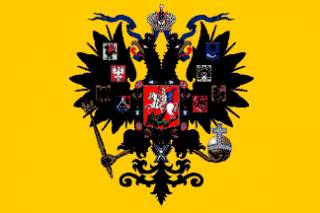
The Russians start out with extra resources which can immediately be turned into villagers or a raiding army to attack with early in the game. This can counteract their beginning with fewer villagers than the other civilizations. Soldiers cost least, which is good since they are weaker than other soldiers. The Stretlet is a cheap example of such a unit, which can be deployed en masse for little cost to the player. Training of infantry takes place in a Blockhouse, which can also defend territory like an Outpost. Both infantry and villagers are trained in groups which allows for faster training at the cost of a larger amount of resources.
Civilization Bonus
- Both villagers and infantry are trained in groups allowing for a low-cost military.
Unique Units
- Strelet
- Cossack
- Oprichnik
Royal Guard Units
- Grenadier
- Cavalry Archer
Home City Ruler
German

Having fewer villagers, the German's economy is slower, but they manage to counteract this with Uhlans that are received for free with every Home City Shipment. The diverse military is late to develop but always includes a strong cavalry. This allows for a varied make-up of the army including strong groups of pike-cleaving Doppelsoldners, Skirmishers, or the mighty War Wagons. Mercenaries can be sent well before other civilizations from their Home City adding a strategic depth to their military.
Civilization Bonus
- With every Home City Shipment you receive free Uhlan units. The amount increases with each successive Age.
Unique Units
- Urban
- Settler Wagon
- Doppelsoldner
- War Wagon
Royal Guard Units
- Skirmisher
- Uhlan
Home City Ruler
Ottoman
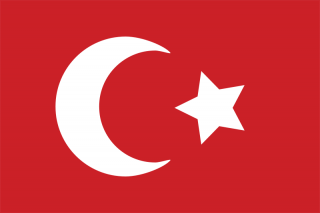
The economy tends to start slowly, not unlike the Germans, but more than makes up for this with their ability to create villagers for free from their Town Center. A Mosque must be built early in the game to keep a constant production of villagers. The player must also continually research improvements for it. Their ability to build the Artillery Foundry before others gives them access to artillery units earlier in the game. The Ottomans have more unique units than the other civilizations.
Civilization Bonus
- There is no cost to spawning villagers in their Town Centers.
Unique Units
- Janissary - The only infantry unit the Ottomans can train
- Abus Gun
- Spahi
- Galley
- Great Bombard
Royal Guard Units
- Grenadier
- Hussar
Home City Ruler
Campaign
The single-player campaign follows three generations of the fictional Black family over the course of three acts (one generation per act). The Black family are adventurers with a passion for the opportunities available in the New World; all in their own way taking part in revolutions, wars, and conquests. Throughout their adventures secret stories of treachery and conspiracy reveal themselves spanning a large portion of the Americas. In the end, the campaign allows the player to take part in a singular story that manages to weave three generations of the Blacks together - offering a much deeper look into the trials and tribulations this one family must face to reach their ultimate goals of conquest.
Age I: Blood
The late 16th century is the backdrop to this first act, as you begin in the role of Morgan Black, who is part of the Knights of Saint John. Resembling a modified version of the Spanish civilization, you assume command of this group as they defend the last stronghold on Malta from Sahin (of the Ottoman Empire). Spanning locations in Mexico, Cuba, Florida, the Carribean, and ultimately the New World, Black is persuaded to help in the destruction of the Fountain of Youth - eventually personally struggling with its true significance to him and his family and whether he should drink its remaining water.
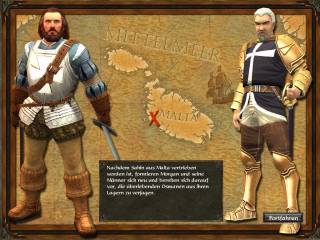
- Mission One - The Falcon Lands on Malta
- Mission Two - Into the Caves
- Mission Three - PIRATES!
- Mission Four - The Ottoman Fort
- Mission Five - Temples of the Aztec
- Mission Six - A Pirate's Help
- Mission Seven - Spanish Treasure Fleet
- Mission Eight - The Fountain of Youth?
Age II: Ice
Set in 1757, you take the role of John Black, Morgan's grandson. Playing as John Black's Mercenaries - which is a modified version of both the German and French civilizations - the tale takes place during the Seven Year's War. Having a strong resemblance to The Last of the Mohicans, you fight with the French as they attempt to colonize the Great Plains setting up relations with several Great Plains tribes along the way. Ultimately trying to stave off the Russian armies that have come down through Alaska, the ultimate conspiracy that is woven through all three acts becomes much more apparent. The end of the act sees John Black putting his own life at risk to secure the fortification of new colonies he is fighting so hard to protect.

- Mission One - Defend the Colony
- Mission Two - Strange Alliances
- Mission Three - The Rescue
- Mission Four - The Seven Year's War
- Mission Five - The Great Lakes
- Mission Six - Respect
- Mission Seven - Warwick's Stronghold
- Mission Eight - Bring Down the Mountain
Age III: Steel
The narrative shifts to Amelia Black in 1817, who is the granddaughter of John Black and heiress of The Falcon Company (a railroad company trying to expand further into the United States). In this final act, the player takes control of the U.S. which is a modified version of the British civilization. The story comes full circle, with the truth and motives behind the conspiracy woven through the first two acts finally being realized. The significance of the Fountain of Youth to the Black family is largely revealed, ultimately becoming a catalyst for a final story of vengeance and understanding. The connection between the three generations of the Black family is finally brought to light, with the importance of Morgan Black and his real motives being revealed.

- Mission One - Race For the Rails
- Mission Two - Hold the Fort
- Mission Three - The Boneguard's Lair
- Mission Four - The Spanish Gold
- Mission Five - Bolivar's Revolt
- Mission Six - Journey through the Andes
- Mission Seven - The Ossuary
- Mission Eight - Last Stand of the Boneguard
Multiplayer
Aoe3 is packed in with a free multiplayer account on Ensemble Studios Online (ESO). Matches can be played through the packed in ESO service, or through a direct IP or LAN connection. The ESO service is comparable to Blizzard's Battle.net providing one central infrastructure for players to play matches and chat with each other. The service is seamlessly integrated into the game itself, negating any need to log into a separate website to play a game or register an account.
Like many modern multiplayer games, the player is continually progressing through a ranking system that influences the type of opponents they are matched up with. In this case, each player establishes a Home City that is given the default rank of Conscript, with the highest rank possible being that of a Field Marshall. A power-rating system is utilized to analyze a players activity in the game and difficulty of the matches. This allows the service to restrict access to some matches based on your rank. Custom maps are supported, allowing for a wide range of game types (i.e. Pirates of the Caribbean, Cats vs Mice) beyond the packed in game types.
Game Expansions
The WarChiefs
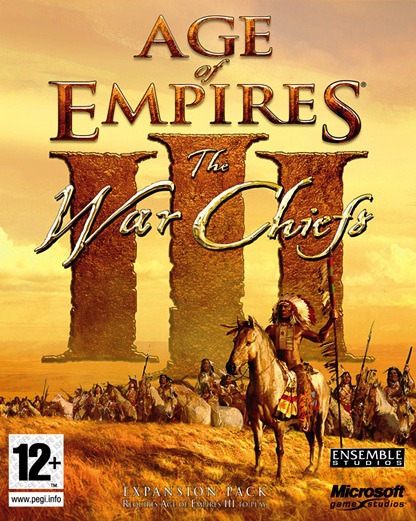
Main page: Age of Empires III: The WarChiefs
The first official expansion pack was released October 4, 2006, and introduces the perspective of the Native Americans. The Iroquois, the Aztec, and the Sioux are all playable in new campaigns designed to shake up many of the strategies that were common with the European civilizations. The civilization bonuses are all tied up around the War Chief unit, providing a very different experience that any of the playable civilizations in the original game.
Main features of Age of Empires III: The WarChiefs:
- Three new campaigns
- Three new playable civilizations: the Iroquois, the Aztec and the Sioux.
- Sixteen new minor tribes, including the Huron, Cheyenne, Zapotec, Apache, Navajo, Klamath and the Mapuche.
- A new victoy condition: Economic Victory
- Revolutions
The Asian Dynasties
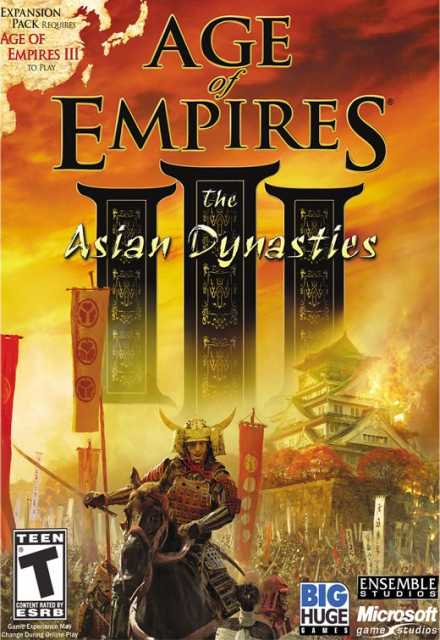
Main page: Age of Empires III: The Asian Dynasties
Releasing in North America on October 23, 2007, the second expansion for AoE3 is the first game in the franchise made by Big Huge Games. This expansion focuses on introducing new content to the game rather than changing the gameplay like The WarChief expansion. Four new game modes including King of the Hill, Regicide, Treaty, and Treaty No-Blockade, are introduced. India, China, and Japan have all new robust campaigns containing five new scenarios apiece. All focus on a return to the civilization based campaigns seen in AoE3. As with both the base game and the first expansion, minor civilizations are playable which here include the Sufis, the Shaolin, the Zen, the Udasi, the Bhakti, and the Jesuits.
Main features of Age of Empires III: The Asian Dynasties:
- Three new campaigns
- Three new playable civilizations: India, China and Japan
- Four new game modes
- New resource, only available for the three Asian civilizations: Export
- Wonders
Original Soundtrack
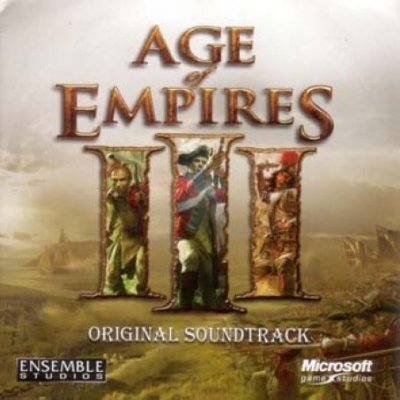
- Noddinagushpa (Main Title)
- Across the Ocean Sea
- Get Off My Band
- Felonious Junk
- Runion
- Pirate's Temper
- I, Menevero
- Scruffy and Underfed
- Leisurely Brows
- Hot Meal
- Bubble Chum
- Of Licious
- Rest with Us
- Get Ye Sum
- Where's My Uncle?
- Muptop
- Meet These French
- Old Timer
- Major Rewrite/General Chunks
- Take His Toes
- Happy to You
- Camels, Straws, And Backs
- Years in the Making
- Last Name Crane, Icabod
- Ludus Perditus (The End of Happy Times)
- Niceterium (The Sound of One Hand Clapping)
- There Is Weather/Decisions Are Made (End Credits)
System Requirements
Minimum System Requirements:

- Operating System: Windows XP
- Processor: 1.4 GHz
- Memory: 256 MB
- Hard Drive: 2 GB
- Video Card: 64 MB with support for hardware transformation and lighting
- Other: sound card & speakers/headphones
Online/Multiplayer System Requirements
- 56k dial-up Internet Access or LAN

 Mac
Mac PC
PC





























